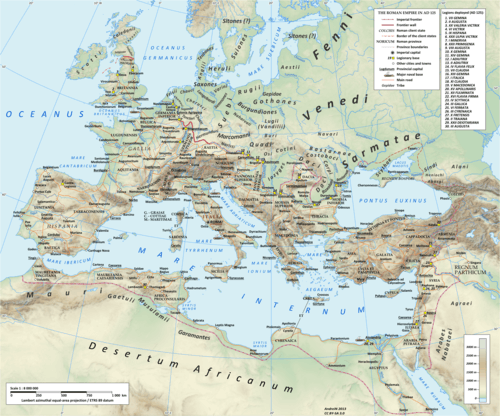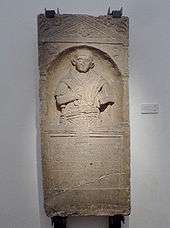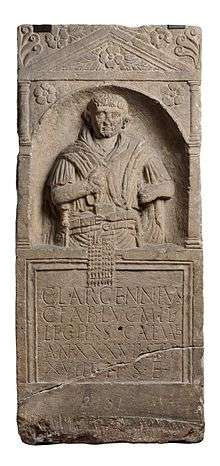Legio II Augusta
Legio secunda Augusta ("Augustus' Second Legion") was a legion of the Imperial Roman army that was founded during the late Roman republic. Its emblems were the Capricornus,[1] Pegasus,[2] and Mars.
| Legio II Augusta | |
|---|---|
 | |
| Active | 43 BC to sometime in the 4th century AD |
| Country | Roman Republic and Roman Empire |
| Type | Roman legion (Marian) |
| Role | Infantry assault (some cavalry support) |
| Size | Varied over unit lifetime. Approx. 3,500 fighting men + support at the time of creation. |
| Garrison/HQ |
|
| Nickname(s) |
|
| Patron | Augustus |
| Mascot(s) | Capricornus, in its sea-goat form the astrological sign of II Augusta's patron, Augustus |
| Engagements |
|
| Commanders | |
| Notable commanders |
|
In Republican service
The Legio II, Sabina was a Roman military unit of the late Republican era, which may have been formed by Julius Caesar in the year of the consulate of 48 BC and coincide, in this case, with the Legio II. Enlisted to fight against Pompey, they took part in the subsequent Battle of Munda of 45 BC.
Alternatively it could be the Legio II, formed by the consul, Gaio Vibio Pansa in 43 BC and recruited in Sabina, hence its nickname.[3] It might have participated in the subsequent battle of Philippi of 42 BC on the side of the triumvirate, Octavian and Marc Antony.[4]
After the defeat of the Republicans, Legio II swore allegiance to Octavian[5] and with the same remained until the battle of Actium of 31 BC,[6] after which it seems to have been dissolved in the years between 30 and 14 BC (sent on leave were between 105,000 and 120,000 veterans[7] and some of its soldiers may have been integrated into the new Legio II Augusta.[5]
In Imperial service
At the beginning of Augustus' rule, in 25 BC, this legion was relocated in Hispania, to fight in the Cantabrian Wars, which definitively established Roman power in Hispania, and later camped in Hispania Tarraconensis. With the annihilation of Legio XVII, XVIII and XIX in the Battle of the Teutoburg Forest (AD 9), II Augusta moved to Germania, possibly in the area of Moguntiacum. After 17, it was at Argentoratum (modern Strasbourg).
Invasion of Britannia
The legion participated in the Roman conquest of Britain in 43. Future emperor Vespasian was the legion's commander at the time, and led the campaign against the Durotriges and Dumnonii tribes. Although it was recorded as suffering a defeat at the hands of the Silures in 52, the II Augusta proved to be one of the best legions, even after its disgrace during the uprising of queen Boudica, when its praefectus castrorum, who was then its acting commander (its legatus and tribunes probably being absent with the governor Suetonius Paulinus), contravened Suetonius' orders to join him and so later committed suicide.
After the defeat of Boudica, the legion was dispersed over several bases; from 66 to around 74 it was stationed at Glevum (modern Gloucester), and then moved to Isca Augusta (modern Caerleon), building a stone fortress that the soldiers occupied until the end of the 3rd century. The legion also had connections with the camp at Alchester in Oxfordshire; stamped tiles record it in the 2nd century at Abonae (Sea Mills, Bristol) on the tidal shore of the Avon (Princeton Encyclopedia).
2nd and 3rd centuries
In 122, II Augusta helped to build Hadrian's Wall.
In 142, II Augusta helped to build the Antonine Wall and are recorded on The Bridgeness Slab.
In 196, II Augusta supported the claim for the purple of the governor of Britannia, Clodius Albinus, who was defeated by Septimius Severus. On the occasion of Severus' Scottish campaign, the Second moved to Carpow, to return to Caerleon under Alexander Severus.

(Musée archéologique de Strasbourg)
Attested members
| Name | Rank | Time frame | Province | Soldier located in | Veteran located in | Source |
|---|---|---|---|---|---|---|
| Caius Largennius | miles | Germania | Argentoratum ? | Argentoratum |  | |
| Lucius Antistius Rusticus | tribunus | c. 69 | Britannia | AE 1925, 126 | ||
| Gnaeus Julius Agricola | tribunus | Britannia | ||||
| Publius Septimius Geta | tribunus | c. 170s | Britannia | |||
| Iulius Marcellinus [14] | centurio [14] | Britannia [14] | Banna [14] | |||
| Poenius Postumius [15] | praefectus castrorum [15] | Britannia [15] | ||||
| Titus Flavius Vespasianus | legatus | AD 42-47 | Britannia | Italy | Rome | Suetonius Vesp. 4; Tacitus Hist. III 44; Josephius Bell. Jud. III 12 |
| Aulus Larcius Priscus | legatus | between 97 and 105 | Britannia | CIL VIII, 17881 | ||
| Aulus Claudius Charax[16] | legatus | c. 141-c. 144 | Britannia | AE 1961, 320 | ||
| Fronto Aemilianus Calpurnius Rufilanus[16] | legatus | 161/169 or 177/180 | Britannia | CIL VII, 98 = RIB 320 | ||
| Quintus Aurelius Polus Terentianus[17] | legatus | between 185 and 190 | Britannia | AE 1965, 240 | ||
| Lucius Julius Julianus | legatus | end 2nd century | Britannia | CIL XI, 4182,CIL VII, 480 | ||
| Tiberius Claudius Paulinus | legatus | early 3rd century | Britannia | CIL XIII, 3162 | ||
| Vitulasius Laetinianus | legatus | between 253 and 259 | Britannia | CIL VII, 107 | ||
| Titus Flavius Postumius Varus | legatus | 3rd century | Britannia | CIL VII, 95 | ||
| Lucius Valerius Geminus | AD 43-66 | Britannia | Alchester | |||
| Flavius Quadratus | aquilifer | ? | Hispania | Olisipo | CIL II, 266 = HEp 11, 2001 | |
| Titus Flavius Rufus | centurio | Italia, Moesia, Dacia | Dacia | CIL XI, 20 = ILS 2082, CIL III, 00971 |
In popular culture
- In his fantasy novel Grail, the author Stephen R. Lawhead states that the legion was ensnared by the black magic of the witch Morgan le Fay, doomed to perpetually wander the mists of Lyonesse.
- Lindsey Davis' character Marcus Didius Falco and his best friend Lucius Petronius Longus both served in the legion during Boadicea's Revolt in AD 60/61, while they were teenagers (probably 19-20 years old). Marcus and Lucius only refer to their service in asides, due to the bad memories of the Revolt and the boredom in a cold, unfriendly country. The scenes of carnage and destruction in Londinium left a deep impression on both of them, with neither keen to return to Brittania. Their internal references also hint that their disgraced prefect, Postumius, did not commit suicide, but instead was executed by the legionaries for his refusal to march to Governor Suetonius's aid during the Revolt, but the legionaries swore an oath never to speak of this to outsiders. Novels that most directly refer to their service in Britain are The Silver Pigs, The Iron Hand of Mars, A Body in the Bath House and The Jupiter Myth.
- It is also the Legion in which Optio Quintus Licinius Cato and Centurion Lucius Cornelius Macro serve during the first five books of the Eagles of the Empire series by Simon Scarrow. The books also cover Vespasian's career as commander of the legion and the invasion of Britain.
- The story of the legion's role in Boadicea's Revolt and the subsequent suicide of its acting commander features in Imperial Governor, George Shipway's 1968 novel about Gaius Suetonius Paulinus.
- The II Legion features in Adrian Goldsworthy's novel series, beginning with Vindolanda, about a fictitious centurion of the legion.
See also
References
- Legions and Veterans: Roman Army Papers 1971-2000 By L. J. F. Keppie page 128
- Legions and Veterans: Roman Army Papers 1971-2000 By L. J. F. Keppie page 129
- L.Keppie. The making of the roman army. pp. 199 and 203.
- E.Ritterling (1924–1925) [1483–1484]. voice Legio, in Realencyclopädie of Klassischen Altertumswissenschaft.
- JRGonzalez. Historia del las legiones romanas. p. 106.
- L.Keppie. The making of the roman army. p. 201.
- Augustus. "Res Gestae Divi Augusti". III: 15 and 16. Cite journal requires
|journal=(help) - "RIB 2203. Distance Slab of the Second Legion". Roman Inscriptions of Britain. Retrieved 18 November 2017.
- Macdonald, Sir George (1934). The Roman wall in Scotland, by Sir George Macdonald (2d ed., rev., enl., and in great part rewritten ed.). Oxford: The Clarendon press. p. 386-387. Retrieved 11 October 2017.
- "Distance Slab of the Second Legion, Duntocher". Retrieved 14 November 2017.
- "RIB 2204. Distance Slab of the Second Legion". Roman Inscriptions of Britain. Retrieved 18 November 2017.
- Macdonald, Sir George (1934). The Roman wall in Scotland, by Sir George Macdonald (2d ed., rev., enl., and in great part rewritten ed.). Oxford: The Clarendon press. p. 387-388. Retrieved 11 October 2017.
- "Distance slab of the 2nd Legion, Caerleith Farm, Duntocher". Retrieved 14 November 2017.
- "PVL Inscriptions - Birdoswald". Per Lineam Valli. Retrieved 2014-02-16.
- "Legio II Augusta". Retrieved 2014-02-19.
- Géza Alföldy, Konsulat und Senatorenstand unter der Antoninen (Bonn: Rudolf Habelt Verlag 1977), p. 298
- Anthony Birley, The Fasti of Roman Britain (Oxford: Clarendon Press, 1981), pp. 261f
Further reading
- livius.org account
- Field, N. (1992). Dorset and the Second Legion. Tiverton: Dorset Books. ISBN 1-871164-11-7.
- Keppie, Lawrence (2000). "The Origins and Early History of the Second Augustan Legion". Legions and Veterans: Roman Army Papers 1971-2000. Stuttgart: Franz Steiner Verlag. pp. 123–147. ISBN 3-515-07744-8.
External links
- LEGIO SECVNDA AVGVSTA, British 1st - 2nd century AD ~ Roman Living History Society
- LEGIO SECVNDA AVGVSTA FACEBOOK PAGE, Facebook Page for British 1st - 2nd century AD ~ Roman Living History Society
- LEGIO SECVNDA AVGVSTA (NL) Dutch 1st - 2nd century AD ~ Roman Living History Society
- Second Legion Augusta (NZ), New Zealand re-enactment group
- Richard Stillwell, ed. Princeton Encyclopedia of Classical Sites, 1976: "Abonae (Sea Mills, Bristol), England"
- Capricorn Rising: Astrology in Ancient Rome: Poetry, Prophecy and Power, article by David Wray. assistant professor of Classics, University of Chicago.


